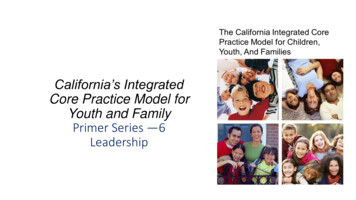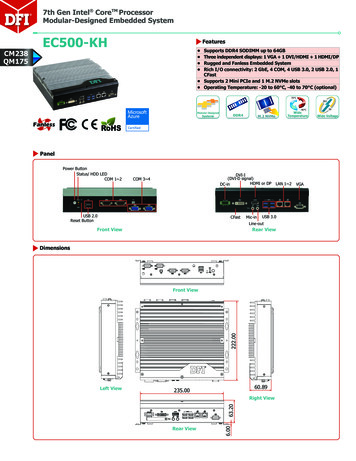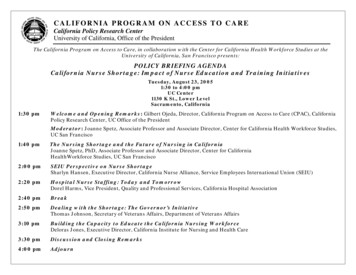
Transcription
California’s IntegratedCore Practice Model forYouth and FamilyPrimer Series —6Leadership
Introduction and Background This is a primer about how the Integrated Core Practice Model cansupport leadership effectiveness and help build Trauma Informed caredelivery. ICPM provides guidance and practice information about the practicevalues, principles and professional behaviors which lead to highquality outcomes for at risk and system-involved youth. California Welfare Director’s CPM Design Team created theseLeadership Behaviors as part of its work toward a practice model.
Goals for Today: Identify and discuss how the state’sIntegrated Core Practice Model supportsleadership practice. Understand the direct link between successfulengagement and good leadership outcomes. Inform development of trauma-centric publicservices for youth and families in California.
“Your work around an integrated practice model isimportant for the field. As a result of your work, CA is in aleadership position in moving the field forward. Whilekeeping all 58 counties going in the same direction is noteasy, the state has come a long way in a relative shortperiod of time.“- Bryan Samuels, Chapin Hall, Former ACF Chief (2017)4
California’s Core Practice Modelis unique!A Shared Approach toCalifornia’s Children, Youthand Families/Integrated Practice GuideShared Theoretical UnderpinningShared Principles and ValuesShared Practice Behaviors (CFT)UniqueProbationTheories,Values, Principlesand PracticesUnique WelfareTheories, Values,Principles andPracticesIntegrated Statewide Training PlanUniqueBehavioralHealth Theories,Values,Principles andPractices
Family Voice and ChoiceNatural SupportsCollaborationTeamingCommunity BasedCulturally CompetentIndividualizedStrength BasedPersistenceOutcomes Based610 CorePrinciples,applied toLeadershipRelations
ICPM Elements of Care1. Engagement2. Assessment3. Service planning anddelivery4. Monitoring and Adapting1. Engagement2. Inquiry andExploration3. Teaming4. Advocacy5. AccountabilityLeadershipPractice5. Transitioning7
Engagement in Leadership Create opportunities to gain new knowledge and skills, try new things,learn from mistakes, and take time to use critical thinking and reflection,even in times of crisis. Establish and maintain regular and frequent communication to encouragean active partnership that engages staff at all levels in implementation andsystem improvement activities. Demonstrate that you care by listening to stakeholders (children, families,community members, and tribes) and staff at all levels to hear theirsuccesses, concerns/worries, and ideas for working together to bothcelebrate successes and overcome barriers. Create regular opportunities to explore and affirm the efforts and strengthsof staff and agency partners, fostering leadership through gains in skill andabilities, confidence, and opportunities to mentor others.
Phase 1—Engagement’sParallelProcessWhen families (staff) are engaged andsupported to have a significant role incase planning (their own development) ,they are more motivated to activelycommit to achieving the case plan(improved performance). And are more likely to recognize andagree with the identified problems; perceivegoals as relevant and attainable; and besatisfied with the planning and decisionmaking process.- Antle, Christensen, van Zyl, & Barbee, 2012; Healy,Darlington, & Yellowlees, 2011; Dawson & Berry, 2001;Jones, McGura, & Shyne, 1981.9
Key Questions in Leadership Engagement?1. How do you know your staff are engaged withyou?2. Who has responsibility for my team’sengagement?3. What supports from mysupervisor/manager/director might assist me tocreate a more engaged work place?10
Inquiry and Exploration Track and monitor barriers and challenges. (Use your data) Be transparent with staff and stakeholders. Seek input and perspective to develop solutions at all stafflevels and with stakeholders. Advance mutually reflective, supportive supervision at alllevels. What is Appreciative Inquiry?
Inquiry and Exploration’s ”Best Practice”:Appreciative Inquiry Based on the work of David Cooperrider and Suresh Srivastva (1987) The questions we ask (and how we ask them) will focus our attentionin a particular direction. If our focus is always problem oriented thenwe are focused on dysfunction, and we may fail to recognize thestrengths in our performance or organizational culture. AI attempts to use ways of asking questions and envisioning thefuture in order to foster positive relationships and build on thepresent potential of a given person, organization or situation. It is “Strength Based” leadership.
Teaming for Leadership Develop partnerships with effective community-based serviceproviders with cultural connections to families receiving services. Work with families, youth, communities, and other stakeholders andpeers as active partners in implementation of best practices, policydevelopment, and problem-solving to support the CPM. Model inclusive decision-making with staff at all levels acrossagencies and with partners using teaming structures andapproaches to implement and support the CPM.
Advocacy Promote advocacy by providing frequent andregular opportunities for tribes, agency partners,staff, youth, families, and caregivers to sharetheir voice. Advocate for the resources needed to supportand develop staff, and to provide effective,relevant, culturally responsive services forfamilies.
Accountability in Leadership Listen and provide timely feedback to staff and stakeholdersand establish a shared expectation for follow-up. Support staff and hold each other accountable for sustaining theCPM by utilizing a practice to policy feedback loop that engagesstaff and stakeholders in data collection and evaluation. (SharedAccountability) Identify and implement a transparent process at all levels totrack staffing gaps and plan organizational changes. Identify and implement a transparent process at all levels tomonitor for practice fidelity and effectiveness.
Effective Leadership Behaviorssupport a Trauma Informed System
Engagement and Secondary Trauma When caring and engaged professionals spend long days workingabsorbing the traumatic stories and experiences of others, itbecomes challenging to process that heaviness consistently andmaintain objectivity and readiness for every day service. It is imperative that helpers invest in helping themselves to copewith the trauma they witness and absorb by caring for themselvesroutinely. How is your supervisory process and organizational culture“Trauma Sensitive”?17
When inadequate Trauma-attunedsupports are in place for staff Staff resign or reassign from service prematurely. Committed staff select alternative roles within socialservices, or careers with less stress and more meaning. High Turnover and Cost to Agency/County Higher Training Costs associated with turnoverYouth care and support can be inadvertentlyinterrupted/Ineffective18
Engagement-Based Compliance Activities Rule driven compliance can create risk of distracting providersand service personnel from the challenging job of healing youth. Engagement driven compliance (as a measure of providereffectiveness and commitment to high quality care) with sensitivity totrauma, can enhance provider capacity for “healing”. When staff are disempowered, it can, for better or worse, have asecondary traumatizing effect on youth in care. Some staff may be former foster youth or persons with livedexperience (including severe trauma).Relationships Business Rules19
Trauma Informed Systems principlesand practices support reflection in placeof reaction, curiosity in lieu of numbing,self-care instead of self-sacrifice andcollective impact rather than siloedstructures.”- Epstein, K, Speziale, K, Gerber, & Loomis, B (2014): SF DPH TIS (Trauma-InformedSystems InitiativeWhat is a Trauma Informed System of Care:Connecting communities to compassionatesystems.
GOVERNMENTTHE Trauma affects organizations andsystems as well as communities andindividuals
Trauma-inducing to Trauma-reducing
Why do we need a TIS?Providers are unableto deliver quality carein an organizationalculture defined bychronic stressors andcollective traumasClient needsvs.HMO modelsFiscalPressuresNo time ationdemandsLawsuits,reforms,task focusFeelingunsafe gDirect andindirecttraumaexposure
What are the values of a TIS?Understanding Trauma & StressWellness for both theworkforce and thecommunity servedthrough relationshipsthat practice TISprinciples.Compassion & DependabilityRelationshipsDevelop CultureSafety & StabilityCultural Humility & ResponsivenessCollaboration & EmpowermentResilience & RecoveryRelationshipsSupport Healing
Trauma Informed ServiceSystems Require:1. Administrative Committent to Change--Trauma and itsimpact are part of how staff members understand peopleand their problems. (Parallel and universal throughout theagency)2. Universal Screening—Even if the agency does not deliverMental health services, an awareness of trauma and itsimpact on the world view of consumers is known anddestigmatized.3. Training and Education— Consistent and Clear; Modeledat every level; informed by awareness of effects ofvicarious trauma.4. Hiring Practices— Recruitment focuses on bringingprofessionals who are aware, mature, relational in theirapproach.5. Review of Policy and Procedures— Each agency policy andguidance document is reviewed to identify how it mightsupport TIC.
The Behavioral Cornerstones ofTrauma Informed Systems EMPATHY—Challenges the fundamental belief that I amalone in my griefENGAGEMENT—Forming of relationships that willcontain the emotions and behaviors of my experience.EMPOWERMENT—The acceptance of responsibility thatI am not constrained to act as a victim of myexperiences. Self Care must be policy based andSystemic.
Likely outcomes of TIC in community Increase in Positive Permanent Outcomes Less job turn-over Fewer personnel/HR investigations Increased communication Greater Job Satisfaction28
Today’s Takeaway-Consistent use of 10 Principles ofICPM in leadership practice notonly enhance outcomes, butcreate trauma-informed agencyand enhance job satisfaction.
Introduction and Background This is a primer about how the Integrated Core Practice Model can support leadership effectiveness and help build Trauma Informed care delivery. ICPM provides guidance and practice information about the practice values, principles and professional behaviors which lead to high quality outcomes for at risk and system-involved youth.










